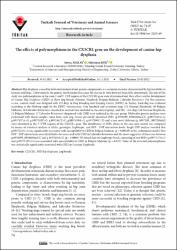| dc.contributor.author | Atalay, Sertaç | |
| dc.contributor.author | Kök, Süleyman | |
| dc.date.accessioned | 2022-05-11T14:07:26Z | |
| dc.date.available | 2022-05-11T14:07:26Z | |
| dc.date.issued | 2022 | |
| dc.identifier.issn | 1300-0128 | |
| dc.identifier.uri | https://doi.org/10.3906/vet-2105-69 | |
| dc.identifier.uri | https://hdl.handle.net/20.500.11776/5106 | |
| dc.description.abstract | Hip dysplasia, caused by both environmental and genetic components, is a common disorder characterized by hip instability in humans and dogs. Unfortunately, the genetic mechanisms that cause the disease in both have not been fully determined. The aim of this study was polymorphisms in the exon 2 and 3' UTR regions of the CX3CR1 gene were determined and their effects on the development of Canine Hip Dysplasia (CHD) in three dog breeds (German Shepherd, Belgian Malinois, Labrador Retriever). For this purpose, a case -control study was designed with 172 dogs in Dog Breeding and Training Center (DBTC) in Turkey. Each dog was evaluated according to the Norberg angle by the DBTC veterinarians. One hundred and seventeen dogs (32 German Shepherds, 49 Belgian Malinois, 36 Labrador Retrievers) classified as normal were included in the control group, and fifty - five dogs (24 German Shepherds, 14 Belgian Malinois, 17 Labrador Retrievers) diagnosed with CHD were included in the case group. Molecular genetic analyzes were performed with blood samples taken from each dog. Seven previously identified SNPs (g.8938599_8938600insCC, g.8937121G>A, g.8937137A>G, g.8937319T>G, g.8937441T>C, g.8937450A>G, g.8937590C>T) and a rare novel deletion (g. 8937205_ 8937206del) were identified in the 3' UTR regions of the CX3CR1 gene. The distribution of SNPs alleles in the case and control was compared by means of statistical analysis at allelic, genotypic, haplotypic, and SNP - SNP interaction levels. Single SNP analysis revealed that g.8937121G>A was significantly associated with susceptibility to CHD in Belgian Malinois (p = 0.00049) in the codominant model. Five SNP - SNP interactions were identified to be associated with CHD in Labrador Retrievers and the most suggestive of these was between g.8938599_8938600insCC and g.8937450A>G (p = 0.0004). We found that one haplotype block, consisting of two SNPs (g.8937137A>G and g.8937319T>G) was associated with susceptibility to CHD in Belgian Malinois (p = 0.022). None of the detected polymorphisms was statistically significantly associated with CHD in German Shepherds. © 2022 TUBITAK. All rights reserved. | en_US |
| dc.description.sponsorship | TUBAP-2018-139 | en_US |
| dc.description.sponsorship | The present study has been supported by the Scientific Research Projects Commission of Trakya University with the project number TUBAP-2018-139. | en_US |
| dc.language.iso | eng | en_US |
| dc.publisher | TUBITAK | en_US |
| dc.identifier.doi | 10.3906/vet-2105-69 | |
| dc.rights | info:eu-repo/semantics/openAccess | en_US |
| dc.subject | CX3CR1 | en_US |
| dc.subject | Dog breeds | en_US |
| dc.subject | Hip dysplasia | en_US |
| dc.subject | SNP | en_US |
| dc.title | The effects of polymorphisms in the CX3CR1 gene on the development of canine hip dysplasia | en_US |
| dc.type | article | en_US |
| dc.relation.ispartof | Turkish Journal of Veterinary and Animal Sciences | en_US |
| dc.department | Rektörlüğe Bağlı Bölümler, Rektörlük, Bilimsel ve Teknolojik Araştırmalar Uygulama ve Araştırma Merkezi | en_US |
| dc.identifier.volume | 46 | en_US |
| dc.identifier.issue | 1 | en_US |
| dc.identifier.startpage | 74 | en_US |
| dc.identifier.endpage | 87 | en_US |
| dc.institutionauthor | Atalay, Sertaç | |
| dc.relation.publicationcategory | Makale - Uluslararası Hakemli Dergi - Kurum Öğretim Elemanı | en_US |
| dc.authorscopusid | 55567956000 | |
| dc.authorscopusid | 55885340800 | |
| dc.identifier.wos | WOS:000752209200001 | en_US |
| dc.identifier.scopus | 2-s2.0-85125177322 | en_US |



















